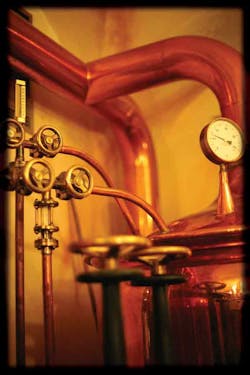Specific places you’ll see these sensors are in production-related process liquids in chemicals, pulp and paper, mining, pharmaceuticals, food and beverage, and semiconductors. That’s because “many applications in these industries contain solids that can coat or damage sensors that protrude into the process piping,” explains Joe Covey, senior product manager with Emerson Process Management’s (www.emersonprocess.com) Rosemount Analytical Liquid group, another vendor, located in Irvine , Calif. Unlike insertion or invasive electrode-less conductivity sensors that must be placed directly into the liquid flow, flow-throughs “actually become a section of the process line,” explains J. Kevin Quackenbush, senior application specialist with Invensys Process Systems’ Measurements & Instruments Division (www.foxboro.com/instrumentation), in Foxboro, Mass. Invensys produces industrial and sanitary flow-through sensors with toroids—doughnut-shaped coils of coated wire that measure conductivity—that don’t protrude into process flow, but route that flow through the bore of the toroids, he explains. Flow-through toroidal conductivity sensors may be ideally suited for slurries. These flow-throughs “provide real-time measurements of chemical concentration in your heavy slurries where other techniques may require frequent cleaning, sample handling systems or frequent sensor replacement,” states Covey. And with flow-throughs, Quackenbush notes that the bore could even be full and the flow not moving—or the liquid is passing through at maximum rate—and accurate measurements can still be made. In March, Invensys launched its FT10 flow-through conductivity sensor. It is geared to measure high-purity liquids; aggressive acids such as hydrofluoric, hydrochloric, nitric and sulfuric; or bases such as ammonium hydroxide and tetra-methyl ammonium hydroxide. It uses patent-pending multi-toroid technology using more than three toroids, says Quackenbush. That patent-pending technology includes more than just additional toroids, though. “It includes how they are paired and positioned, how fields are developed and [how] measurement is made,” Quackenbush says. With the multi-toroid unit, a primary toroid induces current in the process flow, and secondary toroids detect voltage created. That voltage is converted to a conductivity measurement, which indicates concentrations of specific chemicals in the process flow. For high-purity applications, Foxboro equipped the FT10 with virgin PFA
Teflon-wetted materials from DuPont Inc. and leak-free weld connections. The latter eliminate internal threads, O-rings and gasket seals. And for low-volume-flow applications, Foxboro uses small-sized inside-diameter Teflon tubes in the FT10. The device can measure process liquids having temperatures up to 284 degrees Fahrenheit (140 degrees Celsius) and pressures up to 100 pounds per square inch.Brewing beerOne sanitary use of the flow-throughs involves beer brewing. As beer passes through a pipe, the conductivity loop will display a measurement. “At the end of the bottling cycle, the line is flushed out with a clean-in-place (CIP) solution. With the flow-through sensor in place as an integral part of the pipeline, it [the sensor] immediately recognizes the change in conductivity of the CIP solution,” explains Quackenbush, so that the cleaning agent isn’t bottled. He notes too that the flow-through design also allows for in-line calibration while the process is operating. That capability “is critical for sanitary applications,” Quackenbush says. Calibration of a Foxboro sanitary flow-through takes less than 10 minutes, he adds. Besides no process interruption during calibration, “the process line does not have to be opened to access the sensor,” he explains. That’s a “big deal,” Quackenbush observes. “If you have to open a sanitary line, you have to recertify it before proceeding with process.” And that means more expended resources and less production because the process was invaded. C. Kenna Amos, [email protected], is an Automation World Contributing Editor.
Teflon-wetted materials from DuPont Inc. and leak-free weld connections. The latter eliminate internal threads, O-rings and gasket seals. And for low-volume-flow applications, Foxboro uses small-sized inside-diameter Teflon tubes in the FT10. The device can measure process liquids having temperatures up to 284 degrees Fahrenheit (140 degrees Celsius) and pressures up to 100 pounds per square inch.Brewing beerOne sanitary use of the flow-throughs involves beer brewing. As beer passes through a pipe, the conductivity loop will display a measurement. “At the end of the bottling cycle, the line is flushed out with a clean-in-place (CIP) solution. With the flow-through sensor in place as an integral part of the pipeline, it [the sensor] immediately recognizes the change in conductivity of the CIP solution,” explains Quackenbush, so that the cleaning agent isn’t bottled. He notes too that the flow-through design also allows for in-line calibration while the process is operating. That capability “is critical for sanitary applications,” Quackenbush says. Calibration of a Foxboro sanitary flow-through takes less than 10 minutes, he adds. Besides no process interruption during calibration, “the process line does not have to be opened to access the sensor,” he explains. That’s a “big deal,” Quackenbush observes. “If you have to open a sanitary line, you have to recertify it before proceeding with process.” And that means more expended resources and less production because the process was invaded. C. Kenna Amos, [email protected], is an Automation World Contributing Editor.
About the Author
C. Kenna Amos
Contributing Editor
Sign up for our eNewsletters
Get the latest news and updates

Leaders relevant to this article:
